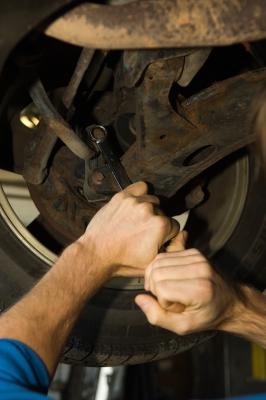
The Chevrolet Monte Carlo SS was introduced in 1970 as the most powerful of the Monte Carlo line. In 1970, this vehicle had a Turbo-Jet 454, 7.4 liter engine with a four-barrel carburetor under the hood. It had 360 horsepower at 4800 rpm and 500 ft-lb of torque at 3500 rpm. Over time, the Monte Carlo SS retained its sporty design and powerful specifications. Restoring a Monte Carlo SS can be a challenging project, but with patience and the right tools, anyone can fully restore this sporty classic.
Purchase handbooks for restoring Chevrolet sport cars, and subscribe to magazines concentrating on restoring classic automobiles. Search for classic Chevrolet enthusiast groups around your neighborhood. Enthusiasts can offer advice, guidance and maybe even assistance with your project. The more knowledge you can acquire concerning restoring these classic Chevy vehicles, the easier it will be to successfully restore one.
Clean a large, enclosed work space that can accommodate a disassembled Monte Carlo SS. Keep in mind that once a Monte Carlo SS has been disassembled, the same vehicle will require three times more space. In addition, you will need extra space for equipment and storage bins. You will also need access to electricity and additional lighting. An organized and spacious work space will help prevent losing parts to your Monte Carlo SS, and will make it easier to complete the restoration.
Place your tarp on a section of the floor and secure it in place, then place parts, accessories and components of your vehicle on the tarp for organization as you disassemble the vehicle. Also, set up labeled containers for keeping track of small pieces.
Disassemble the exterior of your Monte Carlo SS, starting by unbolting and removing the bumpers, hood, front grill, doors and trunk lid. Then disconnect and remove the head and taillights. Loosen the lug nuts on the wheels with a tire iron. Raise the Chevy with a jack, then secure with jack stands placed beneath the frame. Remove the wheels completely. If there is excessive rust on any parts, you may want to apply grease and use a rubber mallet to help disassemble your vehicle.
Unbolt the axles and remove from the frame, then set them aside. Disconnect the engine and similar components within the engine well. You may need to use a hoist to pull the engine and transmission out of the body of your Monte Carlo SS. After removal, place all parts and components onto the tarp. Store all small pieces within the labeled containers in order to keep track of them.
Dismantle the interior of your Monte Carlo SS. Remove the seats and set them aside for separate restoration. Pull up the carpet and discard. Disassemble the console, remove the interior trim and all small pieces such as handles, controls and devices. Check the viability of all interior parts, restoring those that can be used in the restoration and replace those that must be replaced. Re-upholster the seats with a Chevrolet specific re-upholstery kit. Remove the front and rear fenders.
Examine all parts and components that you have removed from your Monte Carlo SS. Clean and restore all viable parts individually and replace those that are too severely damaged. Any metal parts that show signs of excessive rust should be replaced. Replacement parts can be obtained through auto parts merchants, restoration specialists and Chevy dealers.
Examine the body and frame of the Monte Carlo SS for scratches, rust and holes. Repair these diseased areas of metal by performing patchwork. Use your MIG welder to solder healthy metal over the damaged areas. Check the frame, hood, fenders, doors, floorboards, and the body. Severely eroded pieces such as the hood and fenders can be replaced. You must ensure that the body of the truck is straight and smooth before moving on to the next step of restoration.
Attach fenders to the front and rear of the Monte Carlo SS. Use your power sander to sand the exterior of the vehicle until it is smooth and even. Make sure that the panels are aligned, then prime the exterior of the vehicle. Once the primer has dried completely, you can paint the exterior of the Monte Carlo SS.
Restore the engine, transmission, carburetor, radiator, and alternator. Inspect the driveshaft, starter and brake systems for viability, and replace any damaged components. Examine the axles for damage and replace if necessary. If you must, use a hoist to lift the engine and transmission and lower them back into the engine's well. Install the engine and power components, ensuring that they are working properly. Prevent damaging parts by taking your time.
Examine all electrical components to ensure that they are in working condition and replace any damaged components and segments of wiring. Install and rewire the headlights and taillights. Install the brake systems beneath the Monte Carlo SS and on the wheel assemblies. Attach the fenders and bumpers. Install the windshield, then attach the mirrors. Re-chrome any damaged or rusted exterior trim. Install new wheels to the wheel assemblies. Remove the jack stands. Lower the car to the ground and secure the wheels to the frame.
Install the recently re-upholstered seat within the interior. Install new carpeting. To maintain the authenticity of your Monte Carlo SS use factory color schemes and materials specific to Chevrolet. Install door panels, handles, the console and all controls and components. Check to ensure that all interior mechanisms are working properly, then test drive your Monte Carlo SS to complete the restoration process.